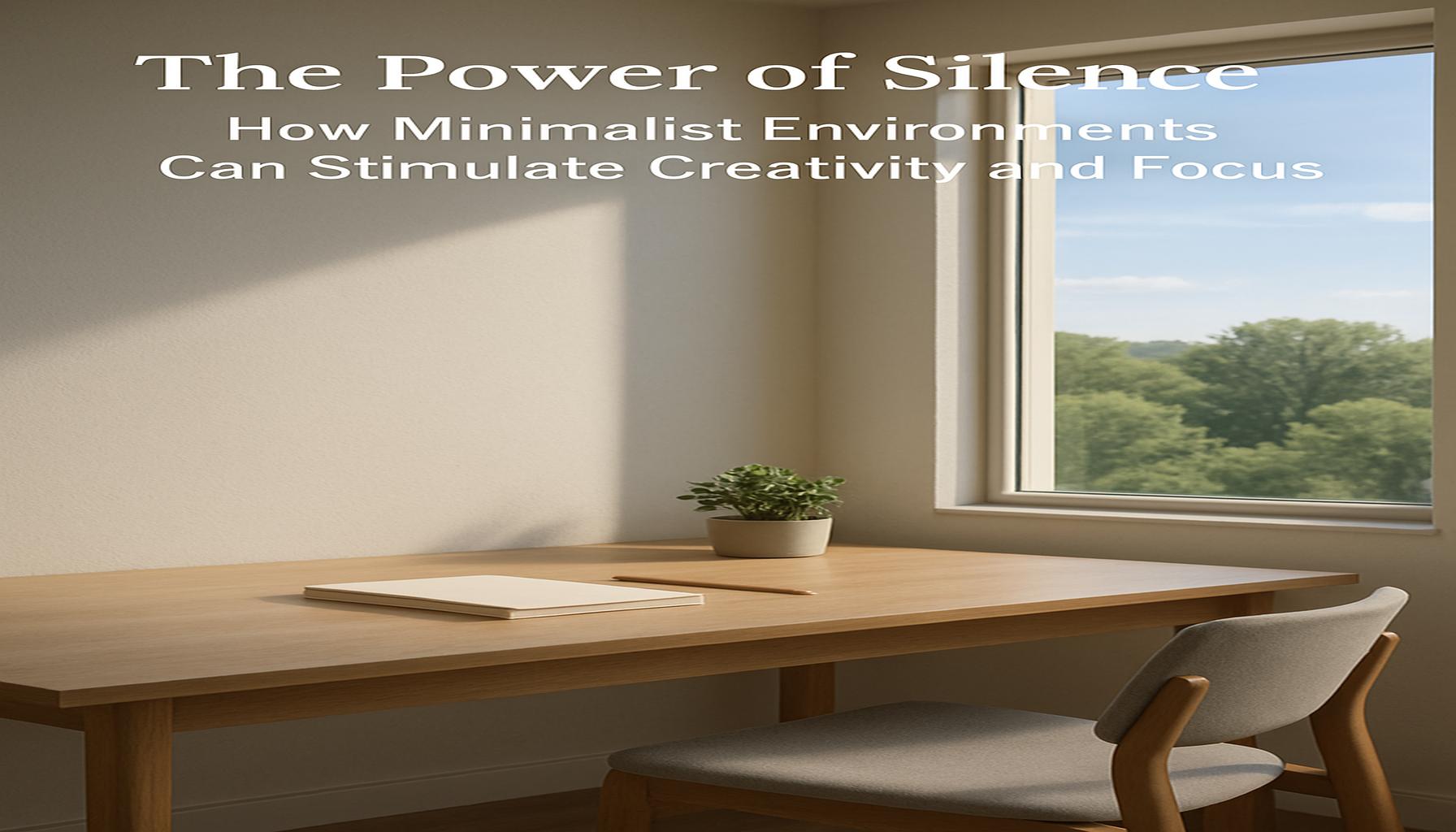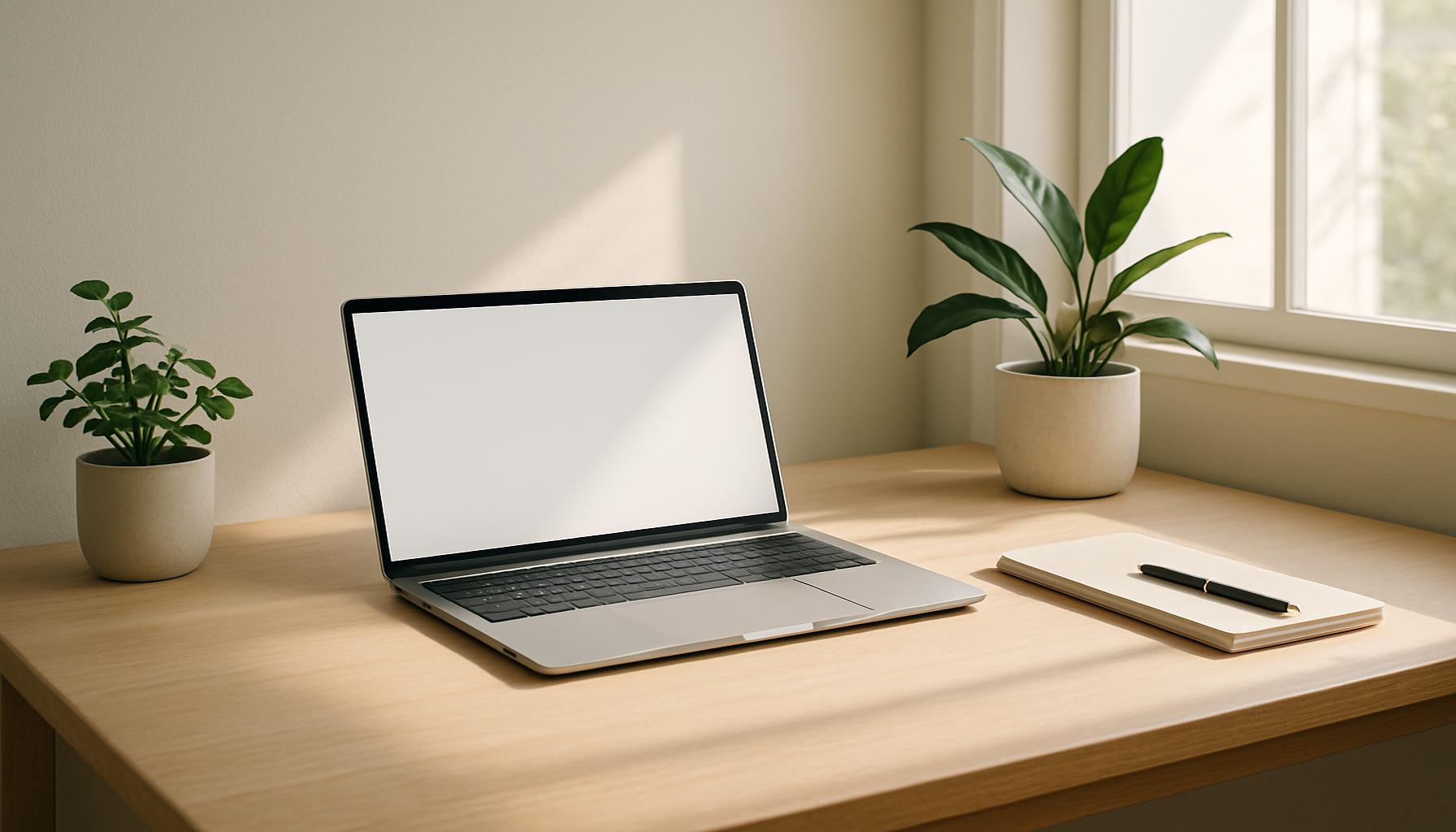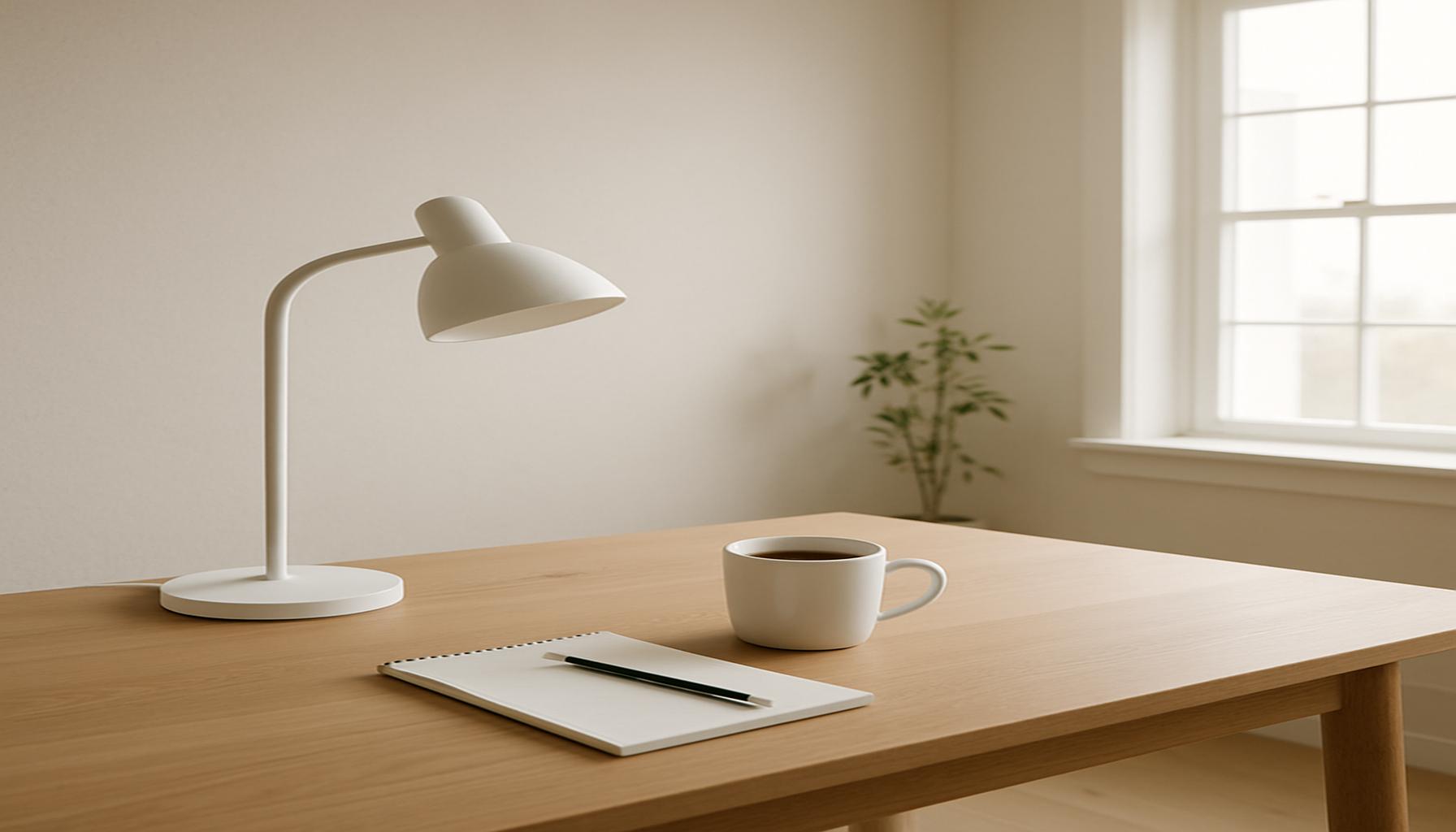The Power of Silence: How Minimalist Environments Can Stimulate Creativity and Focus

Exploring the Transformative Power of Silence
In an era where digital notifications, lively urban environments, and perpetual chatter surround us, the significance of silence often goes unnoticed. However, there is a growing recognition that embracing quietude can lead to profound advancements in both creativity and introspection. Minimalist environments serve as powerful conduits for achieving such tranquility, establishing spaces where the mind can truly thrive. By consciously curating our surroundings, we can indeed unlock our innermost potential.
The essence of minimalism lies in its ability to simplify our lives, leading to numerous advantageous outcomes. Exploring its distinguishing features reveals how they contribute to enhanced focus and inventive thinking:
- Reduced Distractions: One of the most tangible benefits of minimalist environments is the decrease in potential distractions. Research suggests that cognitive overload from excessive stimuli can hinder our ability to concentrate. By minimizing possessions, individuals can better direct their attention to tasks at hand.
- Enhanced Clarity: A well-organized, uncluttered space fosters mental clarity. Imagine working in a serene office devoid of unnecessary decoration; a simple desk and a comfortable chair are all you need to stimulate creativity. This environment encourages a freer flow of thoughts, allowing the mind to explore ideas without hindrance.
- Increased Serenity: A calm atmosphere promotes emotional well-being. Studies link serene surroundings to reduced stress levels, creating an ideal backdrop for creativity to thrive. Being in a quiet space provides an opportunity for deep reflection and innovation.
Extensive research supports the notion that minimalist environments significantly enhance productivity and creativity. For instance, a study published in the journal “Environment and Behavior” found that participants in minimalist settings outperformed those in cluttered areas in both creative problem-solving and task completion. This suggests that achieving a focused mindset is often contingent on the surrounding environment.
To harness the power of silence in your own life, consider integrating minimalist principles into your daily routine. Start by evaluating your living or workspace: can you remove items that no longer serve a purpose? Creating a space dedicated to silence—perhaps a quiet reading corner—can also encourage your mind to rest and regenerate.
Ultimately, the journey towards embracing silence is deeply personal and transformative. By implementing minimalist strategies, you can cultivate a space that not only enhances your productivity but also fosters a deeper sense of peace. The choices you make regarding your surroundings directly impact your ability to focus and create; making them mindfully is the first step toward unlocking your true potential.
DIVE DEEPER: Click here to uncover more strategies
Unveiling the Science Behind Minimalist Design
As we delve deeper into the connection between silence and creativity, it becomes essential to explore the scientific principles underpinning minimalist environments. These principles not only emphasize aesthetic simplicity but also offer profound benefits for mental clarity and cognitive function. The integration of minimalism into workspaces or living areas fosters an atmosphere that invites focus and stimulates innovative thoughts, inspiring individuals to transcend conventional boundaries.
One of the key facets of minimalism is its ability to reduce sensory overload. Our brains are constantly bombarded with information, and research indicates that this can lead to cognitive fatigue. In their study published in the “Journal of Environmental Psychology,” researchers found that individuals exposed to cluttered environments reported higher levels of stress and lower productivity. This aligns with the minimalist philosophy, where less is indeed more. Here are several elements of minimalist design that effectively mitigate distractions:
- Neutral Color Palettes: Utilizing soft, muted colors helps create a calming environment that promotes concentration. Shades of white, gray, and earth tones can minimize visual noise, allowing your brain to focus on critical tasks.
- Decluttered Spaces: A workspace devoid of unnecessary items encourages clearer thinking. The simple act of organizing your desk can lead to a profound shift in productivity. Removing extraneous objects allows you to concentrate solely on your current project or task.
- Functional Furniture: Choosing furniture that is both aesthetically pleasing and functional contributes to an overall sense of order. Ergonomically designed desks and chairs not only improve comfort but also enhance focus, allowing for longer periods of concentrated work.
Additionally, neuroscientific studies illustrate how our brains react favorably to minimalistic surroundings. A report from the American Psychological Association states that environments designed with minimalism in mind can activate brain areas associated with problem-solving and creativity. This suggests that a clutter-free environment is not merely aesthetically pleasing; it is crucial for unlocking cognitive potential.
Adapting to a minimalist mindset requires intentionality and practice. One practical approach is to cultivate a routine that emphasizes organized living and working. This invites individuals to evaluate their environments critically. Consider where distractions exist in your life—both physical clutter and digital interruptions can significantly impact your ability to think clearly.
Creating a designated quiet area within your home or office can bridge the gap between silence and mental acuity. This space might feature a simple chair, a well-placed lamp, and a notebook ready to capture fleeting ideas. Ultimately, embracing minimalist strategies can yield transformative effects on your thought processes, allowing creativity to flourish in the embrace of tranquility.
The Power of Silence: How Minimalist Environments Can Stimulate Creativity and Focus
Minimalist environments are gaining recognition for their potential to enhance creativity and focus. With the rise of busy urban lifestyles inundated with noise and distractions, embracing simplicity can generate a sanctuary for the mind. Research has shown that reducing clutter, both physical and mental, allows individuals to channel their thoughts more effectively, leading to greater productivity and innovative ideas.
Creating a Minimalist Environment
To foster creativity, start with your workspace. Removing unnecessary items and keeping only essential tools enhances clarity and reduces cognitive overload. For instance, a clean desk or a serene room devoid of distractions can significantly impact one’s ability to concentrate. Studies indicate that even the color scheme of a room can influence mood and mental agility. Soft, neutral colors promote tranquility, which in turn can stimulate creative thinking.In addition, sound plays a crucial role in the effectiveness of minimalist environments. For some, complete silence is vital, while others may benefit from soft background noise or nature sounds. This leads to the question of whether intentional silence can provoke deeper cognitive processes. Addressing these preferences empowers individuals to curate their optimal environments for creativity.
Benefits of Minimalism Beyond the Workspace
The principles of minimalism extend beyond workspaces into daily living. By simplifying our surroundings, we cultivate a mindset focused on quality rather than quantity. This shift can cultivate enhanced focus and deeper emotional resilience. Furthermore, minimalist environments promote mindfulness, enabling individuals to become present and engaged. Hence, they can draw inspiration from their immediate surroundings, viewing beauty in simplicity.As you embark on your journey toward a minimalist lifestyle, consider integrating elements that resonate with both your personal style and your focus requirements. Whether that involves choosing calming decor or decluttering your digital spaces, everything contributes to enhancing your overall creative output. Through intentional design and awareness, minimalist environments can open doors to unprecedented levels of inspiration and productivity.
| Category 1 | Category 2 |
|---|---|
| Enhanced Focus | Minimalist environments eliminate distractions, fostering better concentration. |
| Increased Creativity | Simplicity in surroundings allows the mind to explore ideas more freely and innovatively. |
DISCOVER MORE: Click here to learn about the emotional benefits of decluttering
Creating Spaces for Reflection and Innovation
Beyond the aesthetic principles of minimalism, the cultivation of silence within these environments plays a pivotal role in enhancing creativity and focus. A quiet space serves not merely as a backdrop for work; it actively promotes mental clarity and thoughtful reflection. This is particularly pertinent in the hustle and bustle of modern life, where constant connectivity and noise can be overwhelming. Embracing silence is not just a personal choice; it is a practice that can be strategically integrated into our lives.
The psychological impact of quietude is profound. Research published in the “Environmental Science and Technology” journal indicates that exposure to silent environments can reduce stress hormones and improve overall mental well-being. In workplaces that prioritize minimalism, silence can serve as a catalyst for deep thought and innovation. For instance, design firms and tech startups across the United States are beginning to incorporate designated “quiet zones” within their offices, where employees can retreat from the distractions of open office layouts to think, brainstorm, and rejuvenate their creativity.
One of the most illustrative examples comes from the renowned tech company Apple, which is well-known for its minimalist design philosophy in both products and workspaces. Their corporate headquarters, Apple Park, features vast green spaces and quiet areas that encourage employees to engage with nature while reflecting. Studies have shown that such environments not only bolster creative thinking but also promote mental restoration, leading to greater productivity once employees return to their tasks.
Furthermore, the concept of the “think tank” has gained traction in academia and corporate settings. These environments are often designed to facilitate collaboration while also providing areas for uninterrupted thought. By merging minimalism with silence, organizations can create spaces where individuals feel free to explore radical ideas without the interference of noise or clutter. This synergy fosters a culture of innovation that can be powerful in today’s fast-paced economy.
In addition to professional settings, personal environments such as your home can benefit from minimalist principles. Transforming a corner of your living room, setting aside a specific area in your bedroom, or even utilizing your backyard can create personalized sanctuaries of silence. Incorporate elements like soft furnishings, plants, or a simple desk to encourage tranquility. The absence of extraneous stimuli allows you to focus better, whether engaged in writing, painting, or simply contemplating your thoughts.
A growing trend in mindfulness practices highlights the significance of designated silent periods. Techniques such as meditation, which emphasize stillness and self-reflection, can be effectively integrated into everyday routines. Organizations like Headspace and Calm advocate for brief periods of silence throughout the day, encouraging users to step away from digital devices and immerse themselves in stillness. This encourages a mindset shift towards valuing quietness as a crucial component of creativity and productivity.
Ultimately, the integration of silence within minimalist environments requires intentional design choices and lifestyle adjustments. By understanding the profound impact of quietude on cognitive function, individuals and organizations alike can harness the transformative power of silence to foster deeper creativity and enhanced focus.
DISCOVER MORE: Click here to learn about the emotional benefits of decluttering
Embracing the Silence for Enhanced Creativity
As we navigate through the increasingly noisy atmosphere of our daily routines, the profound impact of silence in minimalist environments becomes more apparent. From studies highlighting the psychological benefits of quietude to the innovative strides being made in corporate and personal spaces, it is clear that embracing silence is not merely a luxury—it’s a necessity for cultivating creativity and enhancing focus.
By consciously designing environments that prioritize minimalism and tranquility, individuals and organizations can unlock their potential for deep thinking, innovation, and productivity. Companies like Apple have demonstrated that fostering silence within sleek, open spaces leads not only to enhanced employee satisfaction but also to a significant boost in creative output. The carefully curated quiet zones and think tanks reveal how environments tailored for reflection can invite new ideas and provide mental clarity amidst the chaos of modern life.
Moreover, personal spaces designed with intentionality can transform how we approach our daily endeavors. Whether it’s a reading nook at home or a quiet corner in a café, creating designated areas for silence allows for introspection, creativity, and a deeper connection with our thoughts. As more people embrace mindfulness practices and seek moments of stillness, the understanding of silence as a cornerstone of creativity will only continue to deepen.
Ultimately, recognizing and harnessing the power of silence in minimalist environments offers a pathway to not just enhanced creativity, but a more focused and balanced life. As we integrate these principles into our everyday settings, we may just find that silence becomes one of our greatest allies in the pursuit of innovation and self-discovery.


